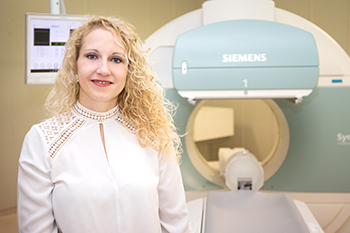
Dr Je’nine Horn-Lodewyk’s tumour detection method
could be the cost-effective breakthrough needed to decrease
the mortality rate in breast cancer patients.
Photo: Anja Aucamp
The field of Nuclear Medicine in South Africa and the rest of the world are expanding rapidly due to the development of hybrid cameras and new radiopharmaceuticals. These developments have a huge impact on the diagnosis and therapy of cancer.
The most advanced of these cameras, Positron emission tomography combined with normal CTs (PETCT), are not yet widely available in South Africa due to the cost of the cameras and the radiopharmaceuticals. A more cost-effective alternative can be of great benefit. To achieve this, the focus should be on developing new radiopharmaceuticals that can be used with the current cost-effective gamma cameras, according to University of the Free State researcher, Dr Je’nine Horn-Lodewyk from the Department of Nuclear Medicine.
Fluorodeoxyglucose (18F-FDG), a radiolabelled glucose analogue, is currently the radiopharmaceutical most commonly used in PET/CT imaging for mainly oncology indications. Although it is considered the gold standard for imaging in several malignancies, it does have certain disadvantages. An 18F-FDG PET/CT diagnostic imaging study can cost between R25 000 and R35 000 for a single patient in the private sector. The 18F-FDG is also more radioactive, which requires much stricter handling and shielding to avoid high radiation dosages to staff and patients.
Successful research potential innovative solution
In the search for the ideal radiopharmaceutical for tumour detection, the South African National Nuclear Energy Corporation (Necsa) developed a local synthesis process for ethylenedicysteine-deoxyglucose (EC-DG). EC-DG is also a glucose analogue similar to FDG. They succeeded in labelling the compound with Technetium-99-metastable-pertechnetate (99mTcO4-), the most common nuclear medicine isotope used for approximately 95% of nuclear medicine procedures, creating 99mTc-EC-DG.
In partnership with Dr Horn-Lodewyk, this compound was successfully used in various animal models and clinical scenarios, resulting in approval by the Medicine Control Council to use it in a human study. Research is also planned in order to investigate diagnostic accuracy in other cancers like lymphoma. The end result of this research can produce a radiopharmaceutical that is cost effective, does not require the use of costly specialised equipment, has no significant side-effects, no special patient preparation, renders late imaging possible, and has decreased radiation risks.
Dr Horn-Lodewyk is grateful for the support of her mentor, Prof Anton Otto, as well as Dr Gert Engelbrecht, Head of the Department of Nuclear Medicine, Prof Jan Rijn Zeevaart from North-West University’s Preclinical Drug Development Platform and Necsa, and Judith Wagener from Necsa. This innovative research would also not have been possible without the financial assistance of Dr Glen Taylor and Eleanor van der Westhuizen in the Directorate of Research Development.